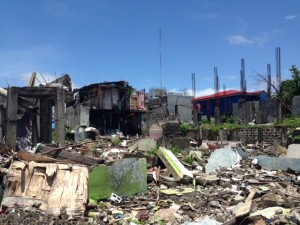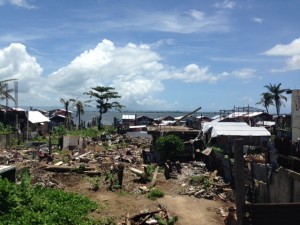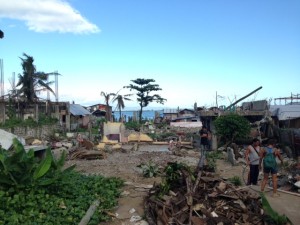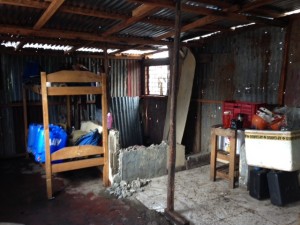 (Note from the editor: This is the latest in a series of blogs from Ariel Neidermeier about her work with All Hands Volunteers to rebuild the Philippines after Typhoon Haiyan. Today’s piece is on the efforts underway in perhaps the hardest hit area, Tacloban.)
(Note from the editor: This is the latest in a series of blogs from Ariel Neidermeier about her work with All Hands Volunteers to rebuild the Philippines after Typhoon Haiyan. Today’s piece is on the efforts underway in perhaps the hardest hit area, Tacloban.)
Photos & Text by Ariel Neidermeier
Our work in Tacloban has shifted to the urban center of the city. Half of the team continues to work on building temporary housing while the other half has begun to clear a plot of land in barangay 48-A located on the coast of Cancabato Bay in downtown Tacloban. Our job is to clear debris and rubble and deconstruct a row of plots spanning the length of what used to be five houses. Currently, there is nothing but rubble.
It takes about 45 minutes to drive from our base camp in Santo Nino barangay into Tacloban’s bustling urban center where most of the worst destruction from Haiyan took place. This is the first project All Hands Volunteers has worked on that is in the heart of the destruction in downtown Tacloban.
When we first drove up to the site, I was shocked. What used to be five houses is now a heap of rubble, trash and discarded pieces of wood. Our job is to clear the rubble and debris so that the owners can rebuild.
A man named Jeremy is the owner of land. He lives in Dubai but has traveled home to  Tacloban for three months to help his family clear the land. This is the first time he’s been back since the storm hit.
Tacloban for three months to help his family clear the land. This is the first time he’s been back since the storm hit.
Jeremy is a soft-spoken man. Over the last week, he’s slowly opened up about his family’s story and loss. His uncle, who was in the house when the storm hit, died in the surge. His body was found down the street. Jeremy’s brother Julio was also in the house when the storm hit. Julio, who prefers “Juli”, is still living on the land in a makeshift shelter in the back of the property. He used to have a technical support shop in the front of the property but it was completely destroyed by the storm. According to Juli, when the water surged, it was ten feet high, almost to the top fronds of a coconut tree that sits on the property. When the surge hit, he and his uncle were separated in the waves which he says were 20 feet high. He survived because he was wearing a life jacket.
 I thought building houses was hard but it pales in comparison to the emotional weight of this project. We spent the first day sorting through debris and picking out items that could be salvaged or reused. We found broken children’s toys, clothes and photo albums. All the items that make up a life and home are tattered and shredded in heaps on the ground; mixed with rubble and covered in black mud. I spent the first day imagining my own home in a pile of rubble and dirt on the ground and had to blink back tears. Imagine finding your own beloved items in shreds on the ground and having to relive the storm and your loss all over again. Our job is to take on this hardship so that Jeremy and Juli don’t have to.
I thought building houses was hard but it pales in comparison to the emotional weight of this project. We spent the first day sorting through debris and picking out items that could be salvaged or reused. We found broken children’s toys, clothes and photo albums. All the items that make up a life and home are tattered and shredded in heaps on the ground; mixed with rubble and covered in black mud. I spent the first day imagining my own home in a pile of rubble and dirt on the ground and had to blink back tears. Imagine finding your own beloved items in shreds on the ground and having to relive the storm and your loss all over again. Our job is to take on this hardship so that Jeremy and Juli don’t have to.
 Thanks for reading. If you would like to support the work of All Hands Volunteers to clear the rubble and rebuild the homes of Filipinos like Jeremy and Juli, please visit my fundraising page. Salamat.
Thanks for reading. If you would like to support the work of All Hands Volunteers to clear the rubble and rebuild the homes of Filipinos like Jeremy and Juli, please visit my fundraising page. Salamat.


RE: Emotional weight of rebuilding Tacloban is heavy: A, Keep up the great work. Please be safe. Love ya, -uj
RE: Emotional Weight of Building Typhoon Haiyan Heavy: Excellent post. I am so proud of the work you and your team are doing. Thank you for sharing your journey and giving us a little insight into how devastating it is.